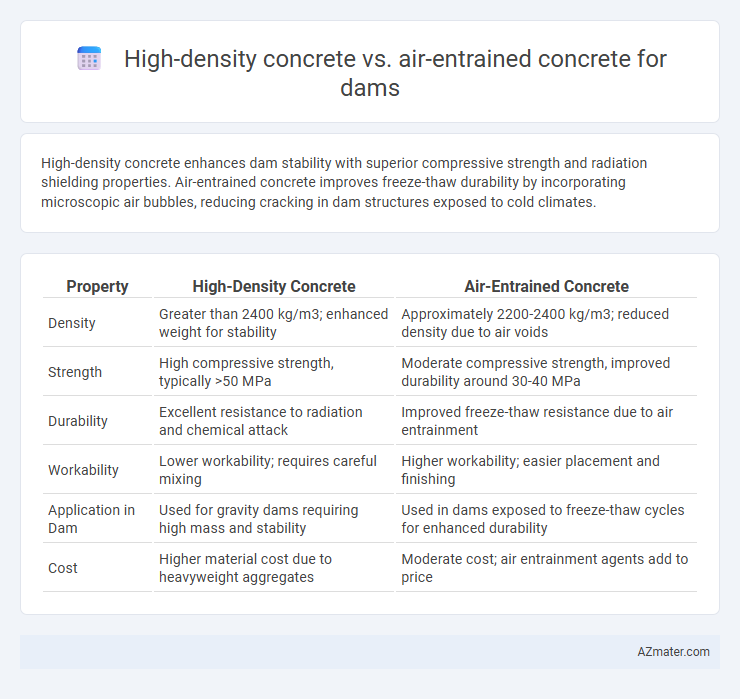High-density concrete enhances dam stability with superior compressive strength and radiation shielding properties. Air-entrained concrete improves freeze-thaw durability by incorporating microscopic air bubbles, reducing cracking in dam structures exposed to cold climates.
Table of Comparison
| Property | High-Density Concrete | Air-Entrained Concrete |
|---|---|---|
| Density | Greater than 2400 kg/m3; enhanced weight for stability | Approximately 2200-2400 kg/m3; reduced density due to air voids |
| Strength | High compressive strength, typically >50 MPa | Moderate compressive strength, improved durability around 30-40 MPa |
| Durability | Excellent resistance to radiation and chemical attack | Improved freeze-thaw resistance due to air entrainment |
| Workability | Lower workability; requires careful mixing | Higher workability; easier placement and finishing |
| Application in Dam | Used for gravity dams requiring high mass and stability | Used in dams exposed to freeze-thaw cycles for enhanced durability |
| Cost | Higher material cost due to heavyweight aggregates | Moderate cost; air entrainment agents add to price |
Introduction to Dam Concrete Technologies
High-density concrete incorporates heavyweight aggregates such as barite or magnetite, providing enhanced radiation shielding and increased structural mass ideal for dam construction. Air-entrained concrete contains microscopic air bubbles that improve freeze-thaw resistance and durability by reducing internal stress from moisture expansion. Choosing between high-density and air-entrained concrete depends on specific dam requirements including load-bearing capacity, environmental exposure, and durability needs.
Overview of High-Density Concrete
High-density concrete incorporates heavy aggregates like barite or magnetite, resulting in a density typically exceeding 3000 kg/m3, which provides enhanced radiation shielding and increased mass for stability in dam structures. Its superior compressive strength and durability make it ideal for absorbing seismic forces and reducing vibrations in large dam projects. Unlike air-entrained concrete, high-density concrete is optimized for load-bearing and radiation protection rather than freeze-thaw resistance.
Key Properties of Air-Entrained Concrete
Air-entrained concrete contains microscopic air bubbles that enhance freeze-thaw resistance and improve durability under cyclic loading, critical for dam structures exposed to harsh weather. Its key properties include increased workability, reduced permeability, and superior resistance to scaling and cracking caused by freeze-thaw cycles. These characteristics make air-entrained concrete essential for maintaining the long-term structural integrity and longevity of dams in cold climates.
Structural Requirements in Dam Construction
High-density concrete offers superior compressive strength and radiation shielding properties, making it ideal for dam sections requiring enhanced load-bearing capacity and durability under high pressure. Air-entrained concrete improves freeze-thaw resistance and permeability, essential for dams exposed to cyclic weather conditions and water seepage, thereby reducing microcracking and durability issues. Combining these materials strategically in dam construction optimizes structural integrity by balancing strength, durability, and resistance to environmental stresses.
Durability and Longevity Considerations
High-density concrete offers superior durability for dams by providing enhanced resistance to radiation, chemical attack, and abrasion, making it ideal for structures requiring prolonged service life under harsh conditions. Air-entrained concrete improves freeze-thaw durability by incorporating microscopic air bubbles that reduce internal pressure from freezing water, thereby minimizing cracking and scaling. For long-term dam performance, the choice between these concretes depends on environmental exposure, with high-density concrete favored in radiation or heavy load zones and air-entrained concrete preferred in regions prone to freeze-thaw cycles.
Resistance to Water Penetration and Freeze-Thaw Cycles
High-density concrete exhibits superior resistance to water penetration due to its low porosity and dense matrix, making it ideal for dam structures requiring enhanced impermeability. Air-entrained concrete incorporates microscopic air bubbles that improve resistance to freeze-thaw cycles by accommodating ice expansion, thus reducing internal cracking and surface scaling. Combining these properties, air-entrained high-density concrete can offer optimized durability against both water ingress and freeze-thaw damage in dam applications.
Density, Strength, and Load-Bearing Performance
High-density concrete used in dam construction exhibits significantly higher density, typically ranging from 3,800 to 4,800 kg/m3, compared to air-entrained concrete which generally has a density of about 2,200 to 2,400 kg/m3. This substantial difference translates into superior compressive strength and enhanced load-bearing capacity for high-density concrete, making it ideal for withstanding immense hydrostatic pressures in dam structures. In contrast, air-entrained concrete offers improved freeze-thaw durability but lower overall strength and load-bearing performance, making it less suitable for critical structural zones of dams where maximum density and strength are essential.
Cost Analysis: High-Density vs Air-Entrained Concrete
High-density concrete typically incurs higher material and production costs due to the use of heavy aggregates like barite or magnetite, which increase overall weight and density, making it more expensive than air-entrained concrete commonly used in dam construction. Air-entrained concrete, with its introduction of microscopic air bubbles, offers enhanced freeze-thaw durability and reduced permeability, often resulting in lower maintenance costs over the structure's lifespan. When evaluating cost-effectiveness for dams, high-density concrete's superior radiation shielding or structural weight benefits must be weighed against the economic advantages of air-entrained concrete's improved durability and lower initial expenditure.
Environmental Impact and Sustainability
High-density concrete, incorporating heavyweight aggregates like barite or magnetite, enhances radiation shielding and durability in dam construction but often involves higher embodied energy and resource extraction impacts compared to conventional materials. Air-entrained concrete improves freeze-thaw resistance by introducing microscopic air pockets, extending dam lifespan with reduced maintenance needs, thus promoting sustainability through lower lifecycle environmental burdens. Choosing between these concretes requires balancing the environmental costs of raw material sourcing against the durability benefits that reduce repair frequency and resource consumption over a dam's operational life.
Best Practices for Selecting Concrete Type in Dams
High-density concrete offers superior radiation shielding and enhanced durability, making it ideal for dams requiring exceptional strength and resistance to environmental hazards. Air-entrained concrete improves freeze-thaw durability and reduces permeability, which is critical for dams exposed to harsh weather cycles and water seepage. Best practices for selecting concrete type in dams involve assessing environmental conditions, load requirements, and exposure risks to optimize performance and longevity.

Infographic: High-density concrete vs Air-entrained concrete for Dam
 azmater.com
azmater.com